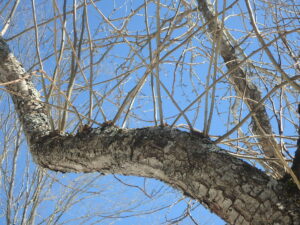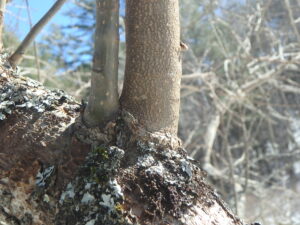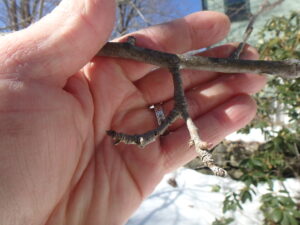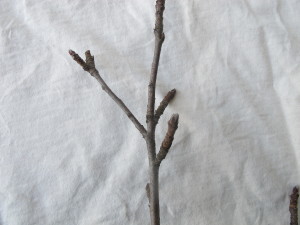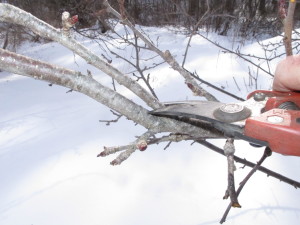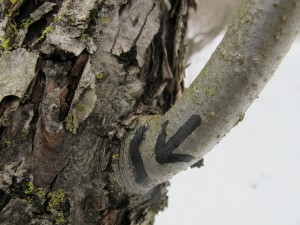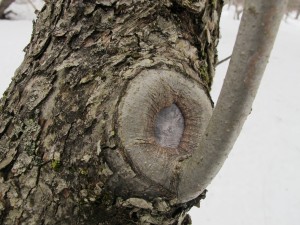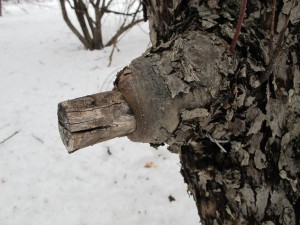It’s Time to Prune Fruit Trees

Pruning saws come in various sizes; loppers are a quick way to cut branches too big for your pruners
Good tools are important for doing a good job. You need sharp by-pass pruners (not the anvil pruners that crush the stems), a pair of good loppers and a small handsaw – folding saws with sharp teeth are good. I have bigger saws for large branches and even a small electric chain saw, but rarely use them.
Water sprouts grow every year on most fruit trees. The first year they are pencil-thin and 12 to 36 inches long. Cut them off as they will just clutter up your tree. Trees grow them in response to a need for more food for the roots, and are most common in shady parts of the tree where leaves are not getting enough sunshine. Some varieties are more prone to growing water sprouts than others, and a hard pruning may stimulate them to grow in large numbers.
Branches often grow away from the center of the tree, as they should, but compete with another branch directly above or below it. Decide which is the better branch, and remove the other. I also look for branches that are headed into the interior of the tree and remove them.
Fruit most often develops on what are called scaffold branches – sturdy branches that leave the trunk on an angle that is almost parallel to the ground, or aiming up slightly. Branches that go more straight up, older water sprouts for example, produce little or no fruit.
Pruning Apple Trees
Often the snow on the hilly south side of my house has melted by early March, allowing snowdrops to push their little noses out of the ground and permitting me to pick buds that open up indoors. Most years by mid-March the snow has melted enough to allow me to get out and move around my apple trees to prune them. Not this year. Snow is still knee-deep here and not disappearing very quickly. It will be April before I get to do much pruning.
The first step in pruning is to really take a good long look at the tree. Are there dead branches? They must go. Are there branches rubbing? You must remove one or the other. What about what I call “invaders”? Invaders are branches that “see” an empty spot and grow willy-nilly through the center of the tree to grab the sunshine. Off with it! Is the interior crowded? If so, it needs work.
Where you make your pruning cuts is important for tree health. Don’t cut branches flush to the trunk or a bigger branch. Don’t cut into the swollen area at the base of a branch, an area called the branch collar. You can often see a distinct edge to the collar where the wrinkles in the bark in the branch collar stop and smooth bark of the branch begin. But don’t cut off branches too far from the trunk, either. That creates stubs that will die and slowly rot away – leaving an open wound where disease can enter.
In general, it is better to take a few bigger branches than lots of little ones. You can safely remove 20 to 25 percent of a tree’s leaves when pruning, though a well-tended tree won’t even need that much. The amount of wood is less important than the number of leaves, though that is a bit difficult to determine in winter. Pruning an old, neglected apple tree might be done with just a few cuts to remove big branches that are competing with the tree’s central leader or cluttering up the interior of the tree. Then in subsequent years you might work on smaller branches.
If you want blossoms and fruit, you can see if a branch will produce apples by looking for fruit spurs. Fruit spurs are gnarly little branches – usually just 3 or 4 inches long – that grow off bigger branches, branches that are at least two or three years old. At the tip of each spur is a cluster of buds that will produce leaves and flowers. If you are deciding whether to remove a branch, look for fruit spurs before cutting. Fruit spurs will not produce fruit in their first year.
Apples (and crabapples) tend to send up lots of waterspouts. These start as pencil-thick twigs shooting straight up from bigger branches. They are often a stress response: in summer they grow to produce leaves in the cool interior of a tree when the outer leaves have stopped producing food for the tree because it’s too hot. So even if you cut them out every year, more will come –often in the same place. Same varieties of trees send out a lot of water sprouts, others just a few. If you leave them in place, they will eventually become full sized nuisance branches cluttering up your tree.
A few words about bad crotches. Fruit bearing branches should be at an angle of 45 to 60 degree angle from the main trunk. A bad crotch angle (30 degrees or less) exist when there is a very tight angle between two stems. If the stems develop heavy fruit loads or are subject to heavy ice and snow loads, the weak crotch may break open, damaging the tree.
Breaking of bad crotches occurs because as the branches grow, they grow together, enclosing bark – and creating a week spot. Prune one of the two branches to correct the problem. Do this when a tree is young if you can. Some trees are more prone to bad crotches than others. Maples, for example, often are full of bad crotch angles (but don’t prune them in spring as they will bleed excessively).
Apples produce the most fruit on branches that are more horizontal than vertical. Sometimes I weight down young branches to make them more horizontal. A milk jug with some water in it will do the job – and you can increase the weight to just the right amount by tying on the jug and adding water. Do that in mid-April and remove it on the Fourth of July.
For me, pruning is not just about getting the most flowers or fruit from a tree, it’s about creating a beautiful form. In winter, especially, I enjoy looking at a well-pruned tree as sculpture. If a tree has big branches hacked off to create a tree with a short profile – as some are in commercial orchards – it is not pleasing to the eye. A tree that tapers toward the top and has nicely spaced branches looks good – and produces a good fruit load, too. Experts say that an apple tree should generally have a central leader or stem that dominates the tree and grows up the middle of it.
Pruning apple trees is one of my seasonal joys. I love sculpting the trees, making them lovely to the eye, healthier and more productive, too. A well pruned apple tree should have enough space between branches that a robin can fly through it – without getting hurt. Un-pruned tree? It’s a messy as an unmade bed. And climbing up an old apple on a blue-sky day to prune it makes me feel like a boy again. I can’t wait.
Henry Homeyer is a professional pruner and the author of 4 gardening books. Reach him at P.O. Box 364, Cornish Flat, NH 03746 or henry.homeyer@comcast.net. His website is www.Gardening-Guy.com.
Spring Pruning
Conventional wisdom has it that fruit trees should be pruned in March, but don’t worry if you haven’t even started yet. I haven’t. There’s no harm in pruning in April, or anytime, really. After the buds on fruit trees open, they are more prone to being knocked off while we work on the trees. But you probably don’t care if you get a few less apples or pears. The snow has been so deep this year that it has been difficult to move ladders around, keeping most of us from starting early.
Pruning is best done with clean, sharp equipment. You’ll need a pair of by-pass hand pruners and a sharp tri-cut pruning saw. Bow saws, once popular, are tough to get in tight places, so the folding saw has taken over. A nice pair of loppers will save time sawing medium-sized branches.
Before beginning, check your pruners to see if they are sharp. I do that with the backside of a fingernail, which I drag lightly across the cutting blade. It should shave off a little of the nail. (If yours are not sharp, read my description of how to sharpen pruners in my book, Organic Gardening (not just) in the Northeast: A Hands-On, Week-by Week Guide. Your library should have it).
Next I clean off any gunk on the blades. I use a special solution called Sap-X with an old green scrubby, but you could use a little sewing machine oil or even kerosene. The blades should open and close easily.
Start working on a tree by studying it for a few minutes. Apples do best with a single leader in the middle and the longest branches near the base, getting shorter going up the trunk. If you have two competing leaders, it would be good to remove one, though in an old tree that might not be practical due to the size.
As you look at the tree, ask yourself which larger branches should be removed. Are there any dead branches? They must be removed, so start by taking them out. Are there branches that are rubbing others, or crossing through the middle of the tree? They can go next. Lastly, remove any watersprouts – those smaller branches shooting straight up.
Some fruit trees produce dozens – or even hundreds – of water sprouts each year. Although some varieties seem more prone to producing them than others, you can minimize their presence by pruning to create a well-balanced tree that allows sunshine to get to each leaf of the tree. Watersprouts are the tree’s effort to produce more leaves to create more food.
Even though it might seem scary, it is better to remove large branches than to nip away at a tree, taking tiny branches. It is more efficient, and makes for a better looking, healthier tree. In any given year you can remove up to a quarter of the tree. That means a quarter of the branches that produce leaves – and hence food for the tree. Taking out a big dead branch doesn’t count at all. A healthy tree allows each leaf to get sunshine. If there are too many branches, they will shade each other out.
Where you make your cuts is important, too. Don’t cut off branches flush with the trunk, nor leave long stubs. Branches should be pruned just outside (away from) the wrinkly flare that starts at the trunk or a larger branch. That area you should leave is called the trunk collar. It is the site where healing takes places fastest. Years ago arborists recommended painting tar over a cut, but that is no longer thought to be a good practice.
If you have an empty place in your tree and wish you had a branch there, sometimes you can bend down a branch and keep it in place until it will stay put – generally around July 4th. But don’t do that until after the leaves appear. You can attach a weight to a small branch. A plastic soda bottle is good: you can add water until it is just the right weight. Or you can tie a bigger branch down to a stake in the ground.
Apples generally are produced on short spurs that occur on scaffold branches that are at a 45 degree angle from the main trunk (or even more horizontal). Branches going straight up are less likely to produce fruit. But don’t be impatient with young trees: they won’t produce fruit until they are good and ready.
Pruning on a warm spring day is great fun, and a good excuse to be outside. And remember, trees are not like people: they benefit by having their limbs removed.
Henry Homeyer lives in Cornish Flat, NH. His Web site is www.Gardening-Guy.com.
Working On Apple Trees
Conventional wisdom has it that pruning apple and pear trees is best done before the flower and leaf buds open. This year many apples and pears are blossoming very early – even before we’ve had a chance to tune them up with an annual haircut.
I spoke recently with UNH Extension fruit tree expert Bill Lord about the effects of pruning after bud break. He explained that we can still prune, but that flower buds are a bit brittle once they start to open. So if you don’t want to lose fruit, be careful as you remove branches. But prune if needed.
Last weekend I worked on a young apple tree that I had planted about 5 years ago. It is shaping up nicely, but needed some work. The central leader, or the shoot that normally grows straight up to be the tallest of all branches, had bent over in the past year and 3 or 4 other branches were competing with it to establish themselves as the tallest.
That’s not good. I straightened the leader by tying it to a 10-foot piece of metal electrical conduit that I placed next to the trunk.
The apical tip (the tip of the tallest branch) of an apple tree produces plant hormones called auxins that control the growth and fruit production of the tree. If there is no clearly defined leader, many branches will reach upward and compete to become the leader, and the tree will not be as fruitful as possible.
A vigorous young tree with no leader often has many unneeded “water sprouts” shooting straight up from its branches. To reduce water sprout production a leader needs to be selected and the competitors either removed (not just cut back a little) or bent downward.
Bill Lord warned that cutting back (or heading off) branches that are competing with the leader results in lots of small branches starting up near the pruning cuts. That creates shade in the center of the tree, which is exactly what you don’t want. Pruning should create open spaces so all the leaves can get sunshine. So remove the entire competing branch or tie it down, don’t just cut off the tip.
You can easily change the angle of a branch when it is still young – say an inch in diameter or less. I did that for three branches on my young apple tree, though Bill Lord told me afterwards that branches are still stiff right now and that early May would be better. I tied a clove hitch around each branch with quarter-inch diameter nylon rope, and then anchored the branches to gallon jugs full of water or to good sized stones. Don’t use wire or narrow twine to tie down a branch – it could cut into the branch.
In order to get good fruit production it is also important to have the scaffold branches of a tree at the proper angle. Scaffold branches are the side branches that will ultimately produce fruit spurs (3-4 inch long branches with fruit buds). Scaffold branches rarely are at a right angle to the trunk, but should be angled up a little bit. Scaffold branches at an acute upward angle are not generally strong (so they may break in an ice storm) and usually do not produce much fruit. They need to be removed or bent to create a better angle.
Getting the soil from under your apple trees tested is a good spring activity. That way you can add minerals to the soil as needed. Bill Lord told me that trees that produce lots of apples often need potassium – he recommends a pound of potassium sulfate for every 5 bushels of fruit harvested, and noted that potassium sulfate is approved for organic gardeners (It’s a naturally occurring compound). He said you can also use Sul-Po-Mag, which is readily available and offers your soil sulfur, potassium and magnesium, if your soil test shows those minerals are needed.
Green sand is another good source of potassium for organic gardeners wishing to add potassium to their soil. Green sand is mined in New Jersey and sold at your feed and grain store or garden center. In addition to potassium, it is said to contain 30 trace minerals from the sea, where it originated. It is a good soil conditioner for heavy clay soils.
Bill Lord also suggests sprinkling a cup of old fashioned 20 Mule Team Borax around a full sized apple tree (or a couple of tablespoons around a young tree) every 3-4 years to add boron, a trace mineral, to the soil. It is needed for good cell wall growth and for fruit and seed development.
So go outside on the next nice day and look at your apple trees. Prune as needed, and try to be sure you have a good vigorous leader at the top of your tree. It will save you work in the future by reducing the number of water sprouts you need to prune out each year.
Henry Homeyer is a gardening consultant, pruner and educator. His Web site is www.Gardening-guy.com. You may e-mail him at henry.homeyer@comcast.net. He is the author of 4 gardening books.



